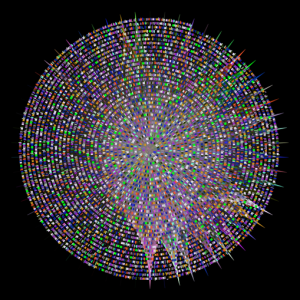Avant, wol. XIII, nr 3, https://doi.org/10.26913/avant3202218
publikowane na licencji CC BY-NC-ND 3.0
Mateusz Machalski
Akademia Sztuk Pięknych w Warszawie
Mateusz Salwa* ![]()
Wydział Filozofii, Uniwersytet Warszawski
*autor korespondujący: mateusz.salwa@uw.edu.pl
Piotr Welk
Akademia Sztuk Pięknych w Warszawie
Przyjęto 17 listopada 2022; zaakceptowano 30 grudnia 2022; opublikowano 2 lutego 2023.
Pełny tekst
Abstrakt: Poster ma na celu zaprezentowanie na konkretnym przykładzie wizualizacji w nauce jako dzieła sztuki. Składa się z dwóch części. Pierwsza to skrócona wersja artykułu oraz graficzna prezentacji owego skrótu, wygenerowana za pomocą algorytmu uwzględniającego rozkład liter w tekście (kod został dołączony). Druga część to hasła zapisane krojem pisma tak dobranym, aby wywoływał napięcie między wizualną stroną hasła (emocjami, myślami, skojarzeniami związanymi z formą) a jego znaczeniem (treścią). Poster zasadza się na założeniach przedstawionych w artykule. Proponujemy mianowicie, aby spojrzeć na wizualizacje danych jako na obiekty, których twórcy stają przed podobnymi wyzwaniami, z jakimi muszą się zmierzyć autorzy dzieł sztuk wizualnych, oraz jako obiekty, których odbiorcy muszą wykonać pracę interpretacyjną podobną do tej, której wymagają od nich dzieła sztuki.
Słowa kluczowe: historia sztuki; kultura wizualna; nauka; sztuka; wizualizacja
Visualisations in science as art works
Abstract: The aim of the poster is to present scientific visualisations as visual art works. In order to do this we offer a particular example. It consists of two parts: a resume of the paper and its graphic representation generated by an algorithm computing the distribution of letters in the resume (the code is attached) and of a set of words printed with fonts creating a tension between their visual aspect (associations, emotions, and thoughts provoked by their form) and their meaning (content). The poster is based on the assumptions discussed in the paper. We suggest that data visualisations should be approached as if they were works whose creators have to cope with issues similar to ones with which creators of visual art works are familiar with and works which have to be interpreted by their users in a similar way to one in which works of art are interpreted by their public.
Keywords: art; art history; visual culture; science; visualisation
Bibliografia
| Baigrie, B.S. (1996). Picturing Knowledge. Historical and Philosophical Problems Concerning the Use of Art in Science. Toronto: University of Toronto Press. https://doi.org/10.3138/9781442678477 |
||||
| Benoît, G. (2019). Introduction to Information Visualization. Transforming Data into Meaningful Information. London: Rowman. | ||||
| Berger, S. (2017). The Art of Philosophy. Visual Thinking in Europe From the Late Renaissance to the Early Enlightenment. Princeton: Princeton University Press. https://doi.org/10.1515/9781400885121 |
||||
| Cairo, A. (2013). The Functional Art. An Introduction to Information Graphics and Visualization. Berkeley: New Riders. | ||||
| Chmielecki, K. (2018). Widzenie przez kulturę: wprowadzenie do teorii kultury wizualnej. Gdańsk: Wydawnictwo Naukowe Katedra. | ||||
| D’Alleva, A. (2008). Metody i teorie historii sztuki, przeł. E. i J. Jedlińscy. Kraków: Universitas. | ||||
| Drucker, J. (2020). Visualizationa and Interpretation. Humanistic Approach to Display. Cambridge: The MIT Press. https://doi.org/10.7551/mitpress/12523.001.0001 |
||||
| Elkins, J. (red.). (2007). Visual Literacy. New York: Routledge. | ||||
| Engebretsen M. i Kennedy H. (red.). 2020. Data Visualization in Society. Amsterdam: Amsterdam University Press. https://doi.org/10.1515/9789048543137 |
||||
| Grugier, M. (2016). The Digital Age of Data Art. Pobrano z https://techcrunch.com-/2016/05/08/the-digital-age-of-data-art/ (15.11.2022). | ||||
| Holmquist, L.E. (2004). Evaluating the Comprehension of Ambient Displays. Pobrano z http://www.chi2004.org (15.11.2022). | ||||
| Kemp, M. (2000). Visualizations: the Nature Book of Art and Science. Oxford: Oxford University Press. | ||||
| Kosara, R. (2007). A Tale of Two Types of Visualization and Much Confusion. Pobrano z http://eagereyes.org/criticism/tale-of-two-types (15.11.2022). | ||||
| Kosara, R. (2010a). Visualization Can Never Be Art. Pobrano z https://eagereyes.org/criticism/visualization-can-never-be-art (15.11.2022). | ||||
| Kosara, R. (2010b). The Visualization Cargo Cult. Pobrano z http://eagereyes.org/criticism/the-visualization-cargo-cult (15.11.2022). | ||||
| Kosińska, M. (red.). (2016). Badania inspirujące się sztuką. Sztuka i dokumentacja, 14(1), nr tematyczny. | ||||
| Leach, Th. (2021). Scientist or artist? Why not be both? Nature Microbiology, 7(4). https://doi.org/10.1038/s41564-021-00995-9 |
||||
| Lima, M., (2011). Visual Complexity. Mapping Patterns of Information. New York: Princeton Architectural Press. | ||||
| Mahoney, M. (2019). The Art and Science of Data Visualization. Pobrano z https://towardsdatascience.com/the-art-and-science-of-data-visualization-6f9d706d673e (15.11.2022). | ||||
| Manovich, L. (2002). Data Visualization as New Abstraction and Anti-Sublime. Pobrano z http://manovich.net/content/04-projects/040-data-visualisation-as-new-abstraction-and-anti-sublime/37_article_2002.pdf (15.11.2022). | ||||
| Neto, J.A.B. (2020). Data Visualization as Art. Pobrano z https://medium.com/xnewdata/data-visualization-as-art-c8301891fe7f (15.11.2022). | ||||
| Paul, Ch. (red.). (2016). A Companion to Digital Art. Oxford: Wiley. https://doi.org/10.1002/9781118475249 |
||||
| Pearson, M. (2011). Generative Art. A Practical Guide Using Processing. Shelter Island: Manning. | ||||
| Pierce, K. (2018). Are Our Genes Really Our Fate? DNA’s Visual Culture and the Construction of Genetic Truth. Nursing Clio; https://nursingclio.org/2018/04/24/are-our-genes-really-our-fate-dnas-visual-culture-and-the-construction-of-genetic-truth [dostęp: 15.11.2022]. | ||||
| Redström, J., Skog, T., Hallnäs, L. (2000). Informative Art: Using Amplified Artworks as Information Displays. Proceedings of DARE 2000 on Designing augmented reality environments, 103-114. https://doi.org/10.1145/354666.354677 |
||||
| Root-Bernstein, R. (1996). Do We Have the Structure of DNA Right? Aesthetic Assum-ptions, Visual Conventions, and Unsolved Problems. Art Journal, 55(1), 47-55. https://doi.org/10.1080/00043249.1996.10791739 |
||||
| Sack, W. (2010). Aesthetics of Information Visualization. W: M. Lovejoy, Ch. Paul, V. Vesna (red.), Context Providers. Conditions of Meaning in Media Arts (s. 123-149). Bristol: intellect. | ||||
| Simanowski, R. (2011). Digital Art and Meaning. Reading Kinetic Poetry, Text Machines, Mapping Art, and Interactive Installations. Minneapolis: University of Minnesota Press. https://doi.org/10.5749/minnesota/9780816667376.001.0001 |
||||
| Starakiewicz, M. (2019). Model i metafora: komunikacja wizualna w humanistyce. Kraków: Korporacja Ha!art. | ||||
| Ware, C. (2021). Information Visualization. Perception for Design. Cambridge: Elsevier. | ||||
| Whitelaw, M. (2008). Art Against Information: Case Studies in Data Practice. The Fibreculture Journal, 11 (https://fibreculturejournal.org/fcj-067-art-against-information-case-studies-in-data-practice). | ||||
| Wright, H. (2007). Introduction to Scientific Visualization. London: Springer. | ||||
| Wrightstone, E., Trumpore, L., Steele, J., Abid, D.M., Newman, D.L., Knight J. (2022). The DNA Landscape: Development and Application of a New Framework for Visual Communication about DNA. CBE-Life Sciences Education, 21(3). https://doi.org/10.1187/cbe.22-01-0007 |
||||



